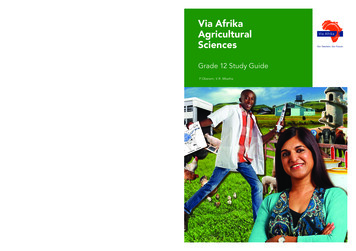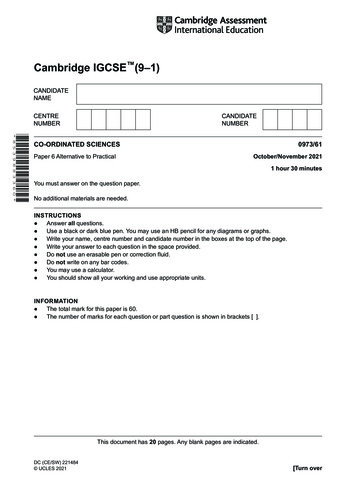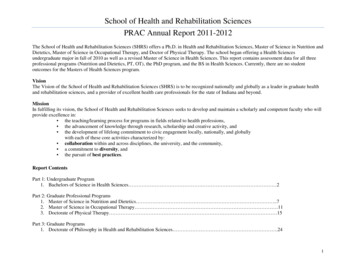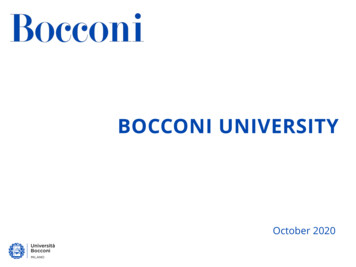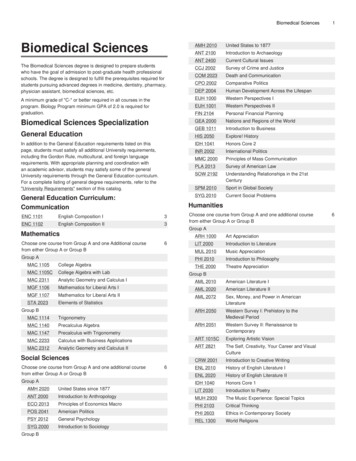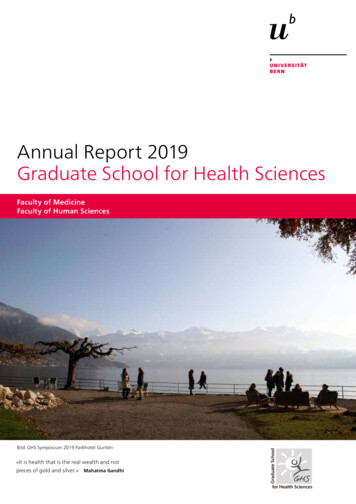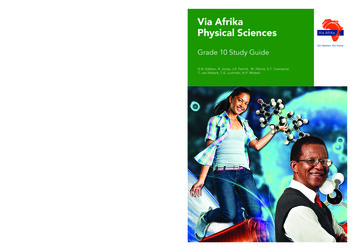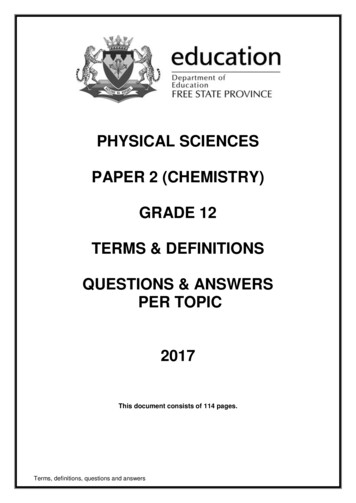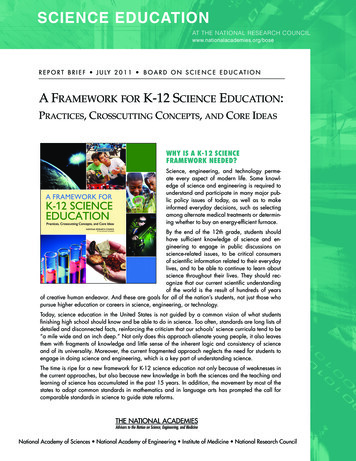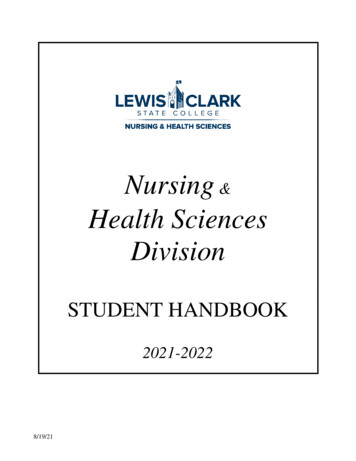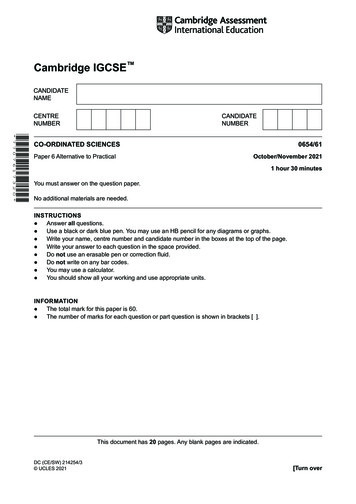
Transcription
Cambridge IGCSE * 7 7 0 7 6 1 7 3 2 0 *CO-ORDINATED SCIENCESPaper 6 Alternative to Practical0654/61October/November 20211 hour 30 minutesYou must answer on the question paper.No additional materials are needed.INSTRUCTIONS Answer all questions. Use a black or dark blue pen. You may use an HB pencil for any diagrams or graphs. Write your name, centre number and candidate number in the boxes at the top of the page. Write your answer to each question in the space provided. Do not use an erasable pen or correction fluid. Do not write on any bar codes. You may use a calculator. You should show all your working and use appropriate units.INFORMATION The total mark for this paper is 60. The number of marks for each question or part question is shown in brackets [ ].This document has 20 pages. Any blank pages are indicated.DC (CE/SW) 214254/3 UCLES 2021[Turn over
21Fig. 1.1 is a full-size photograph of a flower with some of the petals removed.ABFig. 1.1 UCLES 20210654/61/O/N/21
3(a) (i)(ii)(b) (i)In the box, make a large, detailed pencil drawing of the flower.Include the internal parts of the flower.[3]On your drawing, add a labelled line to identify an anther.[1]On Fig. 1.1 draw a line to join points A and B, which shows the width of one petal.Record this width, AB, in millimetres to the nearest millimetre.width of petal AB on Fig. 1.1 . mm [1](ii)Draw a line to show the same width, AB, of the petal on your drawing.Record this width in millimetres to the nearest millimetre.width of petal on drawing . mm [2] UCLES 20210654/61/O/N/21[Turn over
4(iii)Use your measurements in (b)(i) and (b)(ii) to calculate the magnification M of yourdrawing. Use the equation shown.width of petal on drawingM width of petal AB on Fig. 1.1M . [1](c) A student takes the real flower shown in Fig. 1.1 and removes the petal AB. The studentmeasures the width of this petal.Suggest why the width of the real petal is larger than the measurement AB in (b)(i). You canassume all of the widths have been measured accurately. [1](d) The student removes three more petals from the flower.Their widths are shown in Table 1.1.Table 1.1petalwidth/ mm153255351Calculate the average width of these three petals.Show your working.average width . mm [1][Total: 10] UCLES 20210654/61/O/N/21
52A student investigates the nutrient content of samples of honey, milk and rice.The student tests the samples with Benedict’s solution, biuret solution and iodine solution.(a) Table 2.1 shows the student’s observations.Table 2.1final colour observed withfood sampleBenedict’s solutionbiuret solutioniodine lueblueblue-black(i)Name a piece of apparatus suitable to measure 1 cm3 of the testing solution. [1](ii)State which test solution requires the use of heat. [1](iii)Use the observations in Table 2.1 to identify and compare the nutrients present in honey,milk and rice.honey .milk .rice .[5](b) (i)A student tests the honey for the presence of fat.State the two reagents the student needs to use. and .State the observation for a positive result. [2](ii)The test in (b)(i) is not suitable for testing the presence of fat in milk.Suggest a reason why. [1][Total: 10] UCLES 20210654/61/O/N/21[Turn over
63A student investigates the effect of dissolving salt on the boiling point temperature of water.(a) ProcedureThe student:step 1half fills a boiling tube (large test-tube) with distilled waterstep 2heats the water until it boilsstep 3records the boiling point temperature in Table 3.1step 4adds one spatula of salt to the water in the boiling tubestep 5heats the salt solution until it boils and records the boiling point temperature inTable 3.1.The student repeats steps 4 and 5 until seven spatulas of salt have been added.Table 3.1spatulas of saltaddedboiling pointtemperature / C0100.01101.523106.04107.55(i)6108.07108.0Fig. 3.1 shows the thermometer readings for 2 and 5 spatulas of salt added. C C1101101001005 spatulasof salt2 spatulasof saltFig. 3.1Record in Table 3.1 these values to the nearest 0.5 C. UCLES 20210654/61/O/N/21[2]
7(ii)State an improvement to the procedure that will make the results more reliable. [1](b) (i)On the grid draw a graph of boiling point temperature (vertical axis) against number ofspatulas of salt added. Do not start the y-axis at 0.[3](ii)Draw the line of best-fit.(iii)State the relationship between amount of salt added and boiling point temperature.[1]. [2](iv)Use your graph to estimate the boiling point temperature of water when 3.5 spatulas ofsalt are added.Show on your graph how you arrived at your answer.boiling point temperature . C [2](v)The boiling point temperature is the same when 6 and 7 spatulas of salt are added.Suggest why. [1][Total: 12] UCLES 20210654/61/O/N/21[Turn over
84A student investigates boiling and purity.Methanol and water are both liquids and they have been mixed together.The boiling point of methanol is 65 C and the boiling point of water is 100 C.The methanol can be separated from the water by distillation.Fig. 4.1 shows some apparatus.NOT DRAWNTO SCALEFig. 4.1 UCLES 20210654/61/O/N/21
9(a) (i)Draw a diagram of the assembled apparatus used for separating the methanol from thewater by distillation.The boiling temperature of the methanol needs to be measured.Use the following apparatus from Fig. 4.1. a flaska thermometerheating apparatusa condensera beakerany other pieces of apparatus necessary[3](ii)On your diagram label: (iii) UCLES 2021the thermometerthe condenser.[2]On your diagram draw two arrows on the condenser to show where the water enters thecondenser and where it leaves the condenser.[1]0654/61/O/N/21[Turn over
10(b) The boiling point temperature of pure methanol is 65 C.When an impurity is dissolved in a liquid the boiling point temperature of that liquid increases.The boiling point temperatures of four liquids are shown in Table 4.1.The thermometer readings are accurate.Table 4.1(i)liquidboiling pointtemperature / CP64Q60R66S61Deduce which liquid, P, Q, R or S is impure methanol.(ii)[1]Explain why the other three liquids cannot be impure methanol. [1][Total: 8] UCLES 20210654/61/O/N/21
11BLANK PAGE UCLES 20210654/61/O/N/21[Turn over
125A student determines the focal length of a convex lens.(a) ProcedureThe student: sets up the apparatus as shown in Fig. 5.1illuminated objectscreenlampconvex lens in holderFig. 5.1 switches on the lamp and places the screen a distance d 80.0 cm from the illuminatedobject. The illuminated object is shown in Fig. 5.2.illuminated objectFig. 5.2The student: keeps the distance between the illuminated object and the screen constant during theexperimentplaces the lens close to the illuminated object – this is shown in Fig. 5.1moves the lens away from the illuminated object until a sharp triangular image of theilluminated object is formed on the screen.Fig. 5.3 shows the position of the lens when the image is sharp.Fig. 5.3 UCLES 20210654/61/O/N/21
13(i)Measure, and record in centimetres to the nearest 0.1 cm, the distance u1 from theilluminated object to the centre of the lens in Fig. 5.3.u1 . cm [1](ii)Use a ruler to draw a double headed arrow ( ) on Fig. 5.3 to show the object distance[1]u1.(iii)The actual distance of the object is 5 times larger than the distance you have measured.Calculate the actual object distance U1 from the lens.U1 . cm [1](iv)Calculate the focal length fA of the lens. Use the equation shown.fA U1 (80 U1)80fA . cm [1]Fig. 5.4 shows a full size diagram of the image on the screen.Fig. 5.4(v)Measure the vertical height h1 of the image in Fig. 5.4. Record the height in millimetres.h1 . mm [1] UCLES 20210654/61/O/N/21[Turn over
14(b) The student: moves the lens even further away from the illuminated object until another sharptriangular image of the illuminated object is formed on the screenmeasures and records the new distance U2 from the illuminated object to the lens.U2 59.2 cm(i)Calculate the focal length fB of the lens. Use the equation shown.fB U2 (80 – U2)80fB . cm [1](ii)Fig. 5.5 shows a full size diagram of the image on the screen for the new position of thelens.Fig. 5.5Measure the vertical height h2 of the image in Fig. 5.5. Record this height in millimetres.h2 . mm [1](c) Use your results from (a)(iv) and (b)(i) to calculate the average value for the focal length f ofthe lens.f . cm [1](d) Use your answers to (a)(v) and (b)(ii) to calculate the ratio r of the two heights. Use theequation shown.hr 1.h2r . [1] UCLES 20210654/61/O/N/21
15(e) The teacher says that the ratio r h1should be equal to 3.0.h2Two values can be considered to be the same if they are within 10% of each other.State if your result for r can be considered to be the same as the teacher’s value. Justify youranswer with reference to a calculation.statement .justification. [1](f)State one difference and one similarity between the images shown in Fig. 5.4 and Fig. 5.5.difference .similarity .[2](g) State one precaution the student needs to take in this experiment to obtain accurate results.[1][Total: 13] UCLES 20210654/61/O/N/21[Turn over
166Fig. 6.1 shows a pendulum.stringstandpendulum bobFig. 6.1The period of a pendulum is the time taken for one complete oscillation (swing) of the pendulum.Fig. 6.2 shows one complete oscillation.CAABone complete oscillationof the pendulum isABCFig. 6.2 UCLES 20210654/61/O/N/21A
17Plan an experiment to investigate how the period of a pendulum depends upon the mass of itsbob.The apparatus available is listed. You are not required to do this investigation. boss, clamp and standpendulum bobs of different massesa ball of stringa pair of scissorsInclude in your answer: any other apparatus you will needa brief method, including how you will ensure your results are as accurate as possiblethe variables you will controlhow you will process and use your results (you are not required to enter any readings in thetable)how you use your results to reach a conclusion. UCLES 20210654/61/O/N/21[Turn over
18. [7] UCLES 20210654/61/O/N/21
19BLANK PAGE UCLES 20210654/61/O/N/21
20BLANK PAGEPermission to reproduce items where third-party owned material protected by copyright is included has been sought and cleared where possible. Everyreasonable effort has been made by the publisher (UCLES) to trace copyright holders, but if any items requiring clearance have unwittingly been included, thepublisher will be pleased to make amends at the earliest possible opportunity.To avoid the issue of disclosure of answer-related information to candidates, all copyright acknowledgements are reproduced online in the CambridgeAssessment International Education Copyright Acknowledgements Booklet. This is produced for each series of examinations and is freely available to downloadat www.cambridgeinternational.org after the live examination series.Cambridge Assessment International Education is part of the Cambridge Assessment Group. Cambridge Assessment is the brand name of the University ofCambridge Local Examinations Syndicate (UCLES), which itself is a department of the University of Cambridge. UCLES 20210654/61/O/N/21
2 A student investigates the nutrient content of samples of honey, milk and rice. The student tests the samples with Benedict's solution, biuret solution and iodine solution. (a) Table 2.1 shows the student's observations. Table 2.1 final colour observed with food sample Benedict's solution biuret solution iodine solution honey red blue brown
